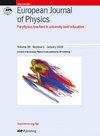氩气法兰克赫兹实验的新特点:实验和蒙特卡罗模拟
IF 0.6
4区 教育学
Q4 EDUCATION, SCIENTIFIC DISCIPLINES
引用次数: 0
摘要
在这项工作中,我们自制了一台仪器,用氩气进行弗兰克-赫兹实验。通过弗兰克-赫兹实验,可以激发氩原子的最低能态和较高能态。利用该装置测量了氩原子的激发能量。对于高能态 3s23p53d 和 3s23p54p 的混合物,氩原子的高激发能量为 13.73 ± 0.28 eV。利用蒙特卡洛方法构建了一个板式电容器模型,模拟电子和氩原子之间的非弹性碰撞。模拟的电流曲线和电子能量分布与弗兰克-赫兹实验结果一致,尤其是高激发态的特征。蒙特卡洛模拟表明,电子与氩原子碰撞过程中能级激发比例的变化导致了电子能量分布的变形。此外,弗兰克-赫兹曲线的新特征归因于氩原子的高激发态。该实验装置已应用于大学本科物理实验教学。学生不仅可以测量氩原子的最低激发态,还可以测量氩原子的高激发态。此外,学生还可以对实验中的弗兰克-赫兹曲线进行蒙特卡罗模拟,在实验中更好地理解电子-氩原子碰撞。新设计的实验将使学生更加熟悉原子物理和量子力学课程中的量子行为。本文章由计算机程序翻译,如有差异,请以英文原文为准。
New Features in Frank-Hertz Experiment with Argon: Experiment and Monte Carlo Simulation
In this work, a homemade apparatus was built to perform the Frank-Hertz experiment with argon. The lowest energy state and the higher energy state of argon can be excited by the Frank-Hertz experiment. The excitation energies of the argon atom are measured by using the setup. The obtained higher excitation energy of argon atoms is 13.73 ± 0.28 eV, for the mixture of higher energy states 3s23p53d and 3s23p54p. A plate capacitor model was constructed to simulate the inelastic collisions between electron and argon atoms using the Monte Carlo method. The simulated current curve and electron energy distribution agrees with that of Frank-Hertz experiments, especially the features of higher excited state. The Monte Carlo simulation indicate the deformed electron energy distribution result from the change in excitation proportion of energy levels during the collisions of electrons and argon atoms. Moreover, the new features in Frank-Hertz curve are ascribed to the higher excitation states of argon atoms. The experimental setup has been applied to undergraduate physics experiment teaching in college. Students can perform the Frank-Hertz curve measurement not only the lowest excited state, but also the higher excited states of argon. In addition, students can do the Monte Carlo simulations for the experimental Frank-Hertz curves and gain a better understanding of electron-argon atom collisions in the experiment. The new designed experiment will make students more familiar with the quantum behavior in atomic physics and quantum mechanics course.
求助全文
通过发布文献求助,成功后即可免费获取论文全文。
去求助
来源期刊

European Journal of Physics
物理-物理:综合
CiteScore
1.70
自引率
28.60%
发文量
128
审稿时长
3-8 weeks
期刊介绍:
European Journal of Physics is a journal of the European Physical Society and its primary mission is to assist in maintaining and improving the standard of taught physics in universities and other institutes of higher education.
Authors submitting articles must indicate the usefulness of their material to physics education and make clear the level of readership (undergraduate or graduate) for which the article is intended. Submissions that omit this information or which, in the publisher''s opinion, do not contribute to the above mission will not be considered for publication.
To this end, we welcome articles that provide original insights and aim to enhance learning in one or more areas of physics. They should normally include at least one of the following:
Explanations of how contemporary research can inform the understanding of physics at university level: for example, a survey of a research field at a level accessible to students, explaining how it illustrates some general principles.
Original insights into the derivation of results. These should be of some general interest, consisting of more than corrections to textbooks.
Descriptions of novel laboratory exercises illustrating new techniques of general interest. Those based on relatively inexpensive equipment are especially welcome.
Articles of a scholarly or reflective nature that are aimed to be of interest to, and at a level appropriate for, physics students or recent graduates.
Descriptions of successful and original student projects, experimental, theoretical or computational.
Discussions of the history, philosophy and epistemology of physics, at a level accessible to physics students and teachers.
Reports of new developments in physics curricula and the techniques for teaching physics.
Physics Education Research reports: articles that provide original experimental and/or theoretical research contributions that directly relate to the teaching and learning of university-level physics.
 求助内容:
求助内容: 应助结果提醒方式:
应助结果提醒方式:


